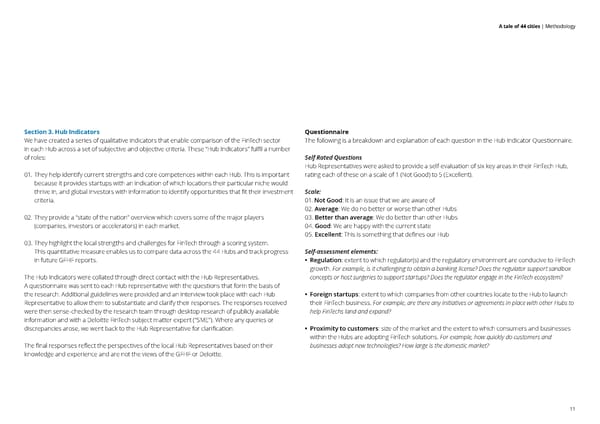A tale of 44 cities | Methodology Section 3. Hub Indicators Questionnaire We have created a series of qualitative indicators that enable comparison of the FinTech sector The following is a breakdown and explanation of each question in the Hub Indicator Questionnaire. in each Hub across a set of subjective and objective criteria. These “Hub Indicators” fulfil a number of roles: Self Rated Questions Hub Representatives were asked to provide a self-evaluation of six key areas in their FinTech Hub, 01. T hey help identify current strengths and core competences within each Hub. This is important rating each of these on a scale of 1 (Not Good) to 5 (Excellent). because it provides startups with an indication of which locations their particular niche would thrive in, and global investors with information to identify opportunities that fit their investment Scale: criteria. 01. Not Good: It is an issue that we are aware of 02. Average: We do no better or worse than other Hubs 02. They provide a “state of the nation” overview which covers some of the major players 03. Better than average: We do better than other Hubs (companies, investors or accelerators) in each market. 04. Good: We are happy with the current state 05. Excellent: This is something that defines our Hub 03. They highlight the local strengths and challenges for FinTech through a scoring system. This quantitative measure enables us to compare data across the 44 Hubs and track progress Self-assessment elements: in future GFHF reports. • Regulation: extent to which regulator(s) and the regulatory environment are conducive to FinTech growth. For example, is it challenging to obtain a banking license? Does the regulator support sandbox The Hub Indicators were collated through direct contact with the Hub Representatives. concepts or host surgeries to support startups? Does the regulator engage in the FinTech ecosystem? A questionnaire was sent to each Hub representative with the questions that form the basis of the research. Additional guidelines were provided and an interview took place with each Hub • Foreign startups: extent to which companies from other countries locate to the Hub to launch Representative to allow them to substantiate and clarify their responses. The responses received their FinTech business. For example, are there any initiatives or agreements in place with other Hubs to were then sense-checked by the research team through desktop research of publicly available help FinTechs land and expand? information and with a Deloitte FinTech subject matter expert (“SME”). Where any queries or discrepancies arose, we went back to the Hub Representative for clarification. • Proximity to customers: size of the market and the extent to which consumers and businesses within the Hubs are adopting FinTech solutions. For example, how quickly do customers and The final responses reflect the perspectives of the local Hub Representatives based on their businesses adopt new technologies? How large is the domestic market? knowledge and experience and are not the views of the GFHF or Deloitte. 11
 A Tale of 44 Cities Page 10 Page 12
A Tale of 44 Cities Page 10 Page 12